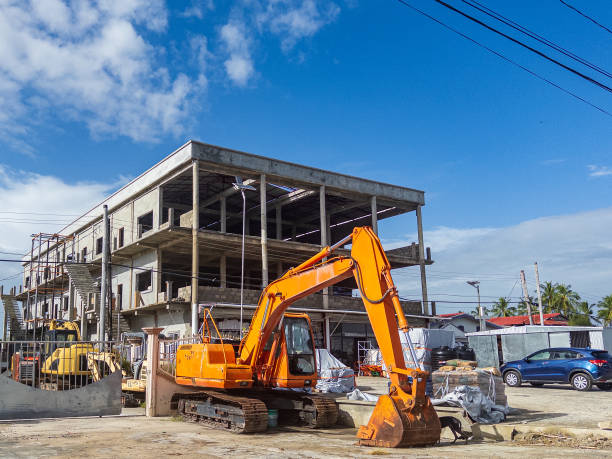Land-Use and Pre-Construction Terms Every Developer Should Know
Starting a new project is exciting, but it also comes with rules and risks. Developers must deal with zoning, permits, and early cost planning before any work begins. Missing one detail can create long delays or even stop a project.
Table of Contents
ToggleThat’s where JDJ Consulting Group helps. Our team guides property owners and developers through these first steps. We simplify zoning codes, review site conditions, and outline a clear path forward. This guide explains the key land-use and pre-construction terms every developer should know before construction.
Development Feasibility & Feasibility Study Basics
What Is a Pre-Construction Feasibility Study?
A feasibility study answers one simple question: Can this project work as planned? It reviews the site, budget, legal rules, and risks. Without this step, developers often face surprise costs or permit issues later.
A good feasibility study:
Reveals problems early
Protects budgets and timelines
Gives confidence to lenders and investors
Prevents wasted effort on unworkable plans
At JDJ Consulting, we prepare these studies to reduce risk and set projects up for success.

Who Conducts the Feasibility Study?
No one person can do it all. A strong study needs a team.
JDJ Consulting Group – checks zoning, entitlements, and permit paths
Architects – test design ideas and confirm building codes
Engineers – look at soil, grading, and utility connections
Environmental experts – review CEQA or other state rules
Financial analysts – create budgets and return-on-investment models
Together, they provide a full picture of what’s possible.
Key Steps in a Feasibility Study
A study usually follows five main steps.
Set project goals – Decide use, budget, and timeline.
Study the site – Review soil, slope, and access issues.
Check zoning – Learn what is allowed and if variances are needed.
Build the numbers – Estimate costs and revenue.
Write the report – Summarize risks and options for decision-makers.
Here are a few common problems that developers face and how to solve them:
| Problem | Effect on Project | Possible Fix |
|---|---|---|
| Wrong zoning type | Blocks planned use | Apply for rezoning or a variance |
| Soil or grading challenges | Raises building and utility costs | Do a geotechnical test, redesign as needed |
| Missing CEQA compliance | Delays approval, adds costs | Complete early environmental studies |
| Soft costs underestimated | Leads to budget overruns | Add consulting, legal, and permit fees |
| Weak market demand | Risk of slow sales or leasing | Run a market study before final scope |
These steps give developers a clear view before investing major funds.
Land-Use Fundamentals & Zoning
What Is Zoning?
Zoning laws decide how land can be used. Cities set rules to separate housing, businesses, and factories. These rules also guide height, density, parking, and open space.
For developers, zoning is often the first hurdle. A project may look great on paper but fail if the zoning code does not allow it. That’s why zoning research is always part of JDJ Consulting’s early review.
Types of Zoning Developers Should Know
Every city organizes land differently, but most zoning falls into a few main categories:
Residential – single-family homes, apartments, townhomes
Commercial – retail, offices, mixed-use shops and housing
Industrial – warehouses, factories, storage facilities
Mixed-use – blends housing, retail, or office space
Special zones – historic areas, overlays, or planned unit developments
Some cities now also use form-based zoning. Instead of focusing on land use, these codes focus on the look and feel of buildings.
Here’s a simple breakdown:
| Zoning Type | Main Use | Developer Note |
|---|---|---|
| Residential | Homes, apartments, townhouses | Density limits and parking rules matter |
| Commercial | Offices, retail, restaurants | Check parking, signage, and use limits |
| Industrial | Factories, storage, distribution | Often has noise and traffic restrictions |
| Mixed-use | Housing with retail or office combined | Often supported in urban areas |
| Special/Overlay Zone | Historic, hillside, or coastal areas | Extra reviews and stricter design controls |
Land-Use Analysis in Pre-Development
Land-use analysis checks whether a site can handle a project. It looks at zoning, environmental rules, traffic, and community impacts.
For example:
Does the project need a variance to exceed height rules?
Will the city require a traffic study?
Is the site in a fire hazard zone or floodplain?
At JDJ Consulting, we handle this due diligence early. This saves developers time and avoids costly redesigns once agencies review the plans.
The Pre-Construction Phase & Key Terms
What Is Pre-Construction?
Pre-construction is the planning period before ground is broken. It is where ideas become detailed plans. Developers create budgets, schedules, and strategies during this stage.
In short, pre-construction is where risk is reduced and clarity is gained. Without it, projects often face cost overruns and permit delays.

Main Activities in Pre-Construction
Pre-construction includes many tasks, each tied to success:
Feasibility studies – confirm site and financial potential
Budgeting – create accurate estimates of hard and soft costs
Scheduling – set timelines for design, review, and permitting
Risk assessment – identify challenges with soil, access, or funding
Team building – bring in architects, engineers, consultants, and contractors
Here’s how activities link to developer goals:
| Activity | Developer Goal | Why It Matters |
|---|---|---|
| Feasibility study | Confirm project is realistic | Avoid wasted design and application costs |
| Budgeting | Plan total project spending | Prevent surprise overruns |
| Scheduling | Set clear timeline | Helps secure financing and city approval |
| Risk assessment | Identify red flags early | Allows fixes before major investment |
| Team building | Gather experts across fields | Creates a coordinated project approach |
Pre-Construction Checklist Essentials
Every developer benefits from a checklist before moving forward. A basic pre-construction checklist should include:
Clear scope of work
Regulatory requirements and permits needed
Safety and accessibility requirements
Resource planning for labor and materials
Communication plan with city officials and consultants
JDJ Consulting creates these checklists for clients. They make sure no step is overlooked before the project enters the entitlement and permitting process.
How JDJ Consulting Group Adds Value Across Pre-Construction
Every development project needs guidance before it can move forward. Rules, costs, and approvals can overwhelm even experienced developers. That is where JDJ Consulting Group steps in. Our role is to simplify the early stages so projects avoid delays and stay financially sound.
We help clients from the very first step — reviewing site potential — all the way to the permit desk at City Hall. By handling technical details, we give developers the freedom to focus on design and investment.
JDJ’s Core Services in Pre-Construction
Here’s how JDJ Consulting supports clients during the early stages of development:
Feasibility Studies – We test if projects make sense based on zoning, budget, and market demand.
Zoning and Entitlement Strategy – We review codes, identify hurdles, and manage applications.
Permit Expediting – We track and speed up approvals through LADBS and other agencies.
Due Diligence – We uncover risks like easements, environmental restrictions, or title issues.
Stakeholder Outreach – We coordinate with neighbors, agencies, and officials to reduce opposition.
Table: JDJ’s Role Across Pre-Construction Phases
| Pre-Construction Phase | Typical Challenge for Developers | JDJ Consulting Solution |
|---|---|---|
| Feasibility Study | Unclear if project is realistic | Provide zoning checks, ROI analysis, and site review |
| Zoning & Entitlements | Complicated city codes and approvals | Develop entitlement strategy and manage applications |
| Permit Process | Long wait times at LADBS and other agencies | Expedite permits and monitor progress daily |
| Budget & Planning | Hidden soft costs and consultant fees | Build complete budgets with all agency requirements |
| Community Relations | Pushback from neighbors or local groups | Lead outreach, negotiate conditions, and build support |
Why This Matters for Developers
Working with a consulting partner saves both money and time. Many projects fail not because of design but because of weak early planning. By addressing risks before plans reach the city, JDJ helps avoid redesigns, costly appeals, or stalled permits.
For developers in Los Angeles, where zoning rules are complex and approvals often move slowly, this support is vital. JDJ’s team knows the agencies, understands the rules, and communicates with stakeholders to keep projects on track.
Structuring Projects for Success: From Concept to Breaking Ground
Good projects don’t happen by chance. They follow a clear structure that moves step by step. Developers who respect this process reduce risk and build stronger returns. At JDJ Consulting Group, we guide clients through this structure so no phase is skipped.
From Pre-Development to Pre-Construction
The early stages of a project often get mixed up. Pre-development and pre-construction sound similar, but they focus on different goals.
Pre-development is the research stage. It covers land-use analysis, market studies, and community outreach.
Pre-construction is the planning stage. It covers budgeting, scheduling, and finalizing permits.
Together, these stages prepare the project for actual construction. Without them, developers risk higher costs and long delays.
Best Practices to Avoid Risk and Delay
Successful projects share a few common habits. These practices keep teams aligned and help developers avoid setbacks.
Define scope early – Write down what the project will and will not include.
Align the team – Get architects, engineers, and consultants on the same page.
Plan for agencies – Build in time for city reviews and permit checks.
Use checklists – Track tasks so nothing falls through the cracks.
Review budgets often – Update numbers as design details change.
Table: Common Risks and How to Avoid Them
| Risk | Impact on Project | Best Practice |
|---|---|---|
| Undefined scope | Endless design changes | Write a clear scope of work at the start |
| Weak communication | Misunderstood goals and wasted time | Set regular team meetings and updates |
| Ignoring city timelines | Missed permit deadlines | Build review periods into the schedule |
| Skipping early site studies | Surprises with soil or utilities | Do geotechnical and utility checks upfront |
| Overlooking soft costs | Budget overruns during approvals | Add consulting, permit, and legal fees early |
Why Structure Matters
When projects follow a structured path, they move faster and face fewer surprises. A clear process also builds confidence with lenders, city agencies, and investors.
At JDJ Consulting, we design this structure for clients. We map out each step, flag risks, and create timelines that match city requirements. This makes it easier for developers to move from concept to groundbreaking without unnecessary delays.
Sample Outline Recap: Land-Use and Pre-Construction Terms Every Developer Should Know
This guide has walked through the core terms and steps that shape land-use and pre-construction in Los Angeles. A quick recap makes it easier to connect the pieces.
Key Takeaways on Land-Use Terms
Zoning sets what you can and cannot build.
Entitlements give official approval to use the land a certain way.
Conditional Use Permits (CUPs) allow special uses beyond zoning limits.
Variances grant exceptions when strict rules don’t fit the site.
Setbacks and FAR (Floor Area Ratio) shape the size and layout of projects.
Key Takeaways on Pre-Construction Terms
Feasibility studies test if the project makes sense.
Due diligence checks land records, surveys, and restrictions.
Soft costs include permits, design, and consulting.
Hard costs are the actual building materials and labor.
Value engineering helps lower costs without hurting design quality.
Table: Land-Use vs. Pre-Construction Terms
| Category | Focus Area | Examples |
|---|---|---|
| Land-Use Terms | Rights, rules, and site potential | Zoning, Entitlements, Variances, CUPs, FAR |
| Pre-Construction | Planning, budgets, and project prep | Feasibility, Due Diligence, Soft Costs, Hard Costs |
Conclusion: Why These Terms Matter for Developers in Los Angeles
Developers who understand land-use and pre-construction terms move faster. They avoid costly mistakes, and earn stronger returns. The language may feel technical at first, but each term tells you how a project will move through the city process.
At JDJ Consulting Group, we help developers cut through the jargon. We explain terms in plain language, handle the paperwork, and build strategies to get approvals on time. With the right partner, even complex projects in Los Angeles can stay on track from concept to construction.
Ready to Move Your Project Forward?
Understanding these terms is the first step. The next step is working with experts who can guide you through Los Angeles pre-construction planning.
At JDJ Consulting Group, we help developers, investors, and property owners save time and unlock the full potential of their sites. Whether you need zoning guidance, permit expediting, or a full feasibility review, our team is ready to support you.
Contact our land use consultants today to schedule a free consultation. See how we can help bring your project from concept to construction. Call us at (818) 793-5058 to take your dream project towards successful completion.
Key Land-Use & Pre-Construction Terms
1. Feasibility Study
Tests if a project is viable—assessing site, zoning, budget, and risks.
2. Zoning & Entitlements
Zoning defines allowed land uses (e.g., residential, commercial, industrial, mixed-use) and overlays like form-based codes or planned unit developments (PUDs).
3. Variances & Conditional Use Permits (CUPs)
Allow exceptions or special permissions when standard zoning doesn’t fit.
4. FAR (Floor Area Ratio)
Ratio of total building area to land area—sets density limits.
5. Pre-Construction Essentials
Includes budgeting (hard & soft costs), schedules, risk assessment, due diligence, and stakeholder coordination.
Frequently Asked Questions: Pre-Construction Terms
What does a General Contractor handle in the pre-construction phase?
A General Contractor manages planning before work begins. They ensure the project is realistic.
Review construction plans and project timelines
Check compliance with building codes
Prepare cost estimation and site clearing steps
This makes the building process smoother and avoids unexpected additional costs.
What is a change order in construction?
A change order updates the original plan or contract terms.
It adds or removes work from the construction agreements
Often changes project timelines and cost of materials
Helps keep the building contracts accurate and legal
Change orders are common when unexpected issues appear during the building process.
Why is the Pre-Construction Phase so important?
The Pre-Construction Phase sets the base for the entire process.
Includes feasibility studies and project estimation
Defines construction plans and material choices
Helps avoid change orders and additional costs later
Without this step, project timelines and budgets often fail.
What are feasibility studies in construction projects?
Feasibility studies confirm if a project is worth building.
Test legal and financial viability
Evaluate site selection and zoning restrictions
Review cost management and potential delays
These studies protect investors before signing building contracts.
What details should be in construction plans?
Good construction plans reduce mistakes and delays.
Architectural plans from building architects
Structural framing and foundation systems
HVAC systems and landscape architect designs
Project timelines and compliance with building codes
Strong plans cut disputes in construction agreements.
Why are building codes essential in the building process?
Building codes keep projects safe and legal.
Ensure quality of materials and safe foundation systems
Regulate HVAC systems, structural framing, and fire safety
Guide General Contractors during inspections
Ignoring codes risks delays, penalties, and failed construction agreements.
What makes building contracts crucial for a project?
Building contracts protect both owner and contractor.
Define payment terms and cost management
List project timelines and delivery dates
Cover damage during construction and warranties
Without a crucial construction contract, disputes rise and trust breaks.
How do pre-construction contracts differ from construction agreements?
Pre-construction contracts cover only planning tasks. Construction agreements cover the full build.
Pre-construction: feasibility studies, estimating software, site clearing
Construction agreements: entire process, payment terms, key clauses
Both reduce disputes with residential builders or architectural firms
Clear separation helps manage cost and scope.
How do project timelines affect the building process?
Project timelines are the backbone of construction work.
Keep residential builders and stakeholders on track
Control additional costs and delays
Guide the sequence of site selection to completion
Timelines bring peace of mind to owners and contractors alike.
Who prepares architectural plans for a project?
Architectural plans are drawn by licensed building architects or architectural firms.
Define the original plan and design details
Include elevations, layouts, and material choices
Must follow building codes before approval
These plans guide both General Contractors and Structural Engineers.
Why do change orders create a huge difference in costs?
Change orders can make or break the budget.
Add labor and material expenses
Extend project timelines significantly
Adjust construction plans and agreements
Strong pre-construction contracts help reduce the number of changes.
What is a Request for Proposals in construction?
A Request for Proposals (RFP) invites firms to compete for a job.
Includes scope of work and pre-construction services agreement
Lists project timelines, key clauses, and payment terms
Helps owners compare bids from General Contractors and architectural firms
This ensures fair pricing and reliable building contracts.






